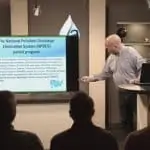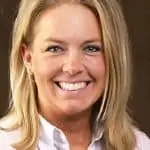

Stormwater Regulation is evolving, pushing more responsibility on to the dischargers by holding them accountable through categorization based on a discharger’s ability to meet numeric benchmarks. Additionally, how a discharger responds and applies effective BMPs determines their status. Ultimately, it is up to the industrial permittee to take the initiative, with an eye to priorities and feasibility for the future of their stormwater compliance program.
Stormwater managers and facility compliance personnel have only just begun to come to terms with the tiered ERA Response paradigm. However, as the tiered escalation becomes more common and ERA Level 1 and Level 2 reporting is performed, facilities are beginning to reach an equilibrium of stormwater compliance in terms of strategy, feasibility, budget and allocation of resources.

In his whitepaper, Jonathan Meronek, QISP, ToR, takes readers through the fundamental components of the ERA, Exceedance Response Action, or tiered Corrective Action compliance mechanism already in place, and currently being implemented in the States of California, Washington and the most recent General Permit in Oregon. ERA has wide-reaching implications for future NPDES permittees of industrial stormwater discharges. The escalation or “tiered” response standards is based on EPA Benchmark Levels and potential for future Numeric Effluent Limits (NELs). The three western states are viewed as “precursors” of what may be expected throughout the United States, as several key components of the forthcoming Multi-Sector General Permit (MSGP) will push other states to move towards similar ERA response scenarios and regulations.
SCS Engineers promotes Carlo Lebron to lead the Southeastern region operations, including all environmental consulting, landfill, landfill gas, and solid waste business. He commences his responsibilities immediately, under the title Business Unit Director, and is managing the staff and business operations of six offices in Florida and Georgia, and including projects in Puerto Rico. His primary office is located in Tampa, Florida.
Today’s landfill design professionals can help eliminate unsafe configurations and institute features that can proactively warn of and minimize hazards for operator and customer safety. Designers consider subgrade conditions, geotechnical factors and regulatory requirements when specifying how steep a landfill may be constructed.
The practical aspects of landfill operations and maintenance play a significant role in slope configurations since the landfill must provide safe access to monitoring points, environmental control features, and mowing.
Bob Gardner highlights the most important features to consider for landfill cells, including the design and construction phases of the entire landfill’s infrastructure. Bob covers a broad range of topics including:
Many states regulate the maximum design slope, and although these vary, it is up to the landfill designer to take practical, safety and regulatory considerations into account when establishing the slope configuration. Bob recommends working closely with the field staff to incorporate a design that is user-friendly, effective and safe.
Read the WasteToday article “Ensuring safety during landfill design,” by clicking here.
About the Author: Bob Gardner, PE, BCEE
…and have fun doing it! In true SCS spirit, our offices are busy helping others in their communities, so that everyone’s holiday is a little bit brighter. A special thanks to our Young Professionals who think BIG, for organizing a national food drive with a healthy competition between our offices. The offices nationwide donated several thousand pounds of food to their local food banks.
In Overland Park, Susan McCart headed up the team’s packaging party to provide 35 custom-made holiday care packages to the members of her son’s Air Force unit. Similarly, our other offices are donating to local causes and to those serving our country.
We are happy that we can help, not just at this time of the year, but year round.
Sustainable environmental programs require multi-disciplinary professionals who have highly technical engineering skills and can develop solutions in coordination with state and local entities, private businesses, and the public.
SCS Engineers announces several strategic management enhancements following its Board of Directors meeting in November. The firm promoted several individuals and hired new professionals to increase support for its landfill, waste management, and clean energy clients in states where recycling goals and the reduction of greenhouse gases are advancing at a rapid pace.
SCS Engineers is an employee-owned corporation, with a Board of Directors that sets policies, appoints officers and committees, and otherwise serves the employee-shareholders by governing the corporation. SCS Engineers includes three specialty business practices: SCS Field Services, SCS Energy, and SCS Tracer.

Promoted to Vice President were Myles Clewner (Florida), Jim Ritchie, Srividhya Viswanathan, Art Jones, and Sol Sim (California); and Tom Lock (Pennsylvania).
SCS also welcomes new Project Director, Daniel Dietch, to its Miami, Florida, office. Mr. Dietch comes to the firm with more than 20 years of academic and professional experience in solid waste management. His experience includes master planning, landfill closure plans, operations and technology reporting, rate models and cost-benefit analyses, data management, and procurement. His expertise will help support achieving state and local sustainable recycling and waste management goals. Mr. Dietch is also the Mayor of Surfside, Florida, and brings the unique big-picture perspective of a public servant.
“These colleagues are a key part of our success, and we are proud to announce their promotions,” said President and CEO Jim Walsh. “Our clients and SCS are thriving as new professionals join with our best and brightest employee-owners.”
$50 million+ will be made available this year.
With the passage of the BUILD Act this year, there are important changes to the grant applications including special consideration given to communities and projects on any waterfronts or floodplains. There are three categories of opportunities for Brownfield grant funding, as follows:
Multipurpose Grants – each proposal is funded up to $800,000 over five years. EPA anticipates selecting ten proposals.
Assessment Grants – Community-wide and Site-specific proposals are each funded up to $200,000 over three years; Assessment Coalition proposals are funded up to $600,000 over three years. EPA anticipates selecting 114 proposals.
Cleanup Grants each proposal funded up to $500,000 over three years. EPA anticipates selecting 40 proposals. Brownfield sites where EPA Cleanup Grant funds were previously expended may not receive additional EPA Cleanup Grant funding in FY 2019.
EPA is hosting a webinar on December 11, 2018, at 2 pm (ET). The webinar is to assist applicants with understanding the Multipurpose, Assessment, and Cleanup Grant Guidelines. Participants can join the audio conference line at 1-866-299-3188 using access code: 202-566-1817, and the web conference at
SCS Engineers routinely and successfully supports our clients with Brownfield’s grant writing and grant application reviews, in addition to our Brownfields and Remediation Services.
Applications are due by January 31, 2019. Please contact Amy Dzialowski, our Brownfields Grant Specialist or if you have a property or redevelopment district that you think is a good fit for pursuing these funds, or for a conversation regarding this program.
Amy Dzialowski, Project Director, and SCS’s Brownfields Grants National Expert
Brownfields and Voluntary Remediation Experts: Mike McLaughlin, Sr. VP, and Dan Johnson, VP.
We will continue to see changes on the federal, state and local regulatory front that together will help us manage storm water in a smart, cost-effective manner preserving our water resources. Betsy Powers of SCS Engineers provides an update in her most recent article.
Until a new WOTUS definition is finalized, the U.S. EPA and the U.S. Department of the Army have indicated their intent to re-codify the pre-Obama regulations. The revised WOTUS rule is expected to include looser regulatory requirements, meaning fewer waters will qualify, and therefore, fewer permits will be required.
To speed up approvals of permits for highways, bridges, pipelines and other major infrastructure, an Obama-era executive order aimed at reducing exposure to flooding, sea level rise and other consequences of climate change were rolled back reducing the environmental reviews and restrictions on government-funded building projects in flood-prone areas.
Removing phosphorus from storm water runoff is a hot topic, with partners exploring alternative opportunities to reduce the introduction of phosphorus in runoff, remove it or manage it in watersheds.
More proprietary filters are being used for pretreatment before underground infiltration for redevelopment sites for total suspended solids (TSS) control and where land is limited. The performance of proprietary devices continues to be studied and improved to meet regulatory requirements. Increasing general attention is being paid to emerging contaminants that are problematic in storm water runoff. Among the emerging contaminants of concern are pharmaceutical and personal care products, pesticides, hydrocarbons, and hormones. Many of which are now included within the Endocrine Disrupting Chemicals group.

Betsy Powers is a civil and environmental engineer with SCS Engineers.
Of interest to industries concerned with wastewater ammonia treatment or landfill leachate ammonia treatment.
SCS Engineers publishes a new SCS Technical Bulletin entitled “Treatment of Ammonia in Wastewater and Leachate – Considerations and Technologies.”
Reducing the amount of ammonia in landfill leachate and other industrial wastewaters are often necessary to meet discharge standards. Proven wastewater treatment technologies can effectively reduce ammonia concentrations, but selecting the right technology requires careful consideration. This SCS Technical Bulletin provides background on ammonia in wastewater, and reviews factors to consider in selecting a treatment technology. The Bulletin includes a review of eight of the most common and effective treatment and disposal methods for wastewater with elevated ammonia or nitrogen.
Read or share the SCS Technical Bulletin here.
Explore SCS’s Liquids Management resources here.
Thanks to those of you who joined SCS Engineers at the Iowa Recycling & Solid Waste Management Conference during our presentation on Dane County, Wisconsin’s successful construction and demolition (C&D) waste processing facility.
We’ve posted our C&D facility presentation online in a short video format.
For those who missed it, here is a quick recap of what helped make the facility a success. Dane County converted a C&D transfer station located at their landfill property into a fully operational C&D processing facility. A public-private partnership makes C&D recycling a more economically viable endeavor, by leveraging strengths among the public and private entities.
With a pricing structure that creates a strong incentive for LRR to recycle, more C&D is beneficially reused, and the County extends the life of its landfill.
SCS supported the County in this award-winning project by managing the design and construction of the facility. Want to discuss your C&D operations? Contact your SCS Engineers representative today, or visit our website that includes this and other case studies, whitepapers, articles, and events.
Thank you to the Iowa Recycling Association and Iowa Society of Solid Waste Operations for sponsoring another valuable conference. See you next year!
Ann O’Brien helps industrial and agricultural companies stay abreast of the regulatory information necessary to remain compliant with federal and state policies. Ann’s most recent series of articles for businesses in the printing or agricultural industries provides advice on air permits and the need for addressing the limits on visible emissions likely specified in their air permits.
Here’s what you need to know about what visible emissions are, how they’re regulated, and how to stay in compliance with your air permit. For other industries, please feel free to contact any SCS office or email us at service.scsengineers.com. We provide our professional services nationwide.

